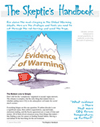|
|
Ken Stewart has scanned the trend maps at BOM (Bureau of Meteorology), and his point is spot on. As soon as I saw the neat joint six page advertising pamphlet for the climate-theory-backed-by-bankers, I wondered what happened to the first 60 years of last century, and Ken found it. Did the BOM forget they have hundreds of data points from back then? Did they forget to use their own Website, where you can pick-a-trend, any-trend, and choose the one with err…more convenient results? Or is it the case that their collective mission is not necessarily to provide Australians with the most complete and appropriate information available, but with what the bureaucracy needs them to know? And what they need them to know, apparently, is the carefully censored version of the truth that will keep government ministers happy (Let us tax them more!), keep department heads smiling (Let the climate cash cow continue!), and last, but not least, help staff feel good (We’re sure we’re helping the environment!).
Why censor half their own data?
The trend map page works exquisitely well (I am happy to praise the BOM Web site team). Compare these two trend maps:
Australian Rainfall Trends 1960-2009
[…]
Frank Lansner has done some excellent follow-up on the missing “decline” in temperatures from 1940 to 1975, and things get even more interesting. Recall that the original “hide the decline” statement comes from the ClimateGate emails and refers to “hiding” the tree ring data that shows a decline in temperatures after 1960. It’s known as the “divergence problem” because tree rings diverge from the measured temperatures. But Frank shows that the peer reviewed data supports the original graphs and that measured temperature did decline from 1960 onwards, sharply. But in the GISS version of that time-period, temperatures from the cold 1970’s period were repeatedly “adjusted” years after the event, and progressively got warmer.
The most mysterious period is from 1958 to 1978, when a steep 0.3C decline that was initially recorded in the Northern Hemisphere. Years later that was reduced so far it became a mild warming, against the detailed corroborating evidence from raobcore data.
Raobcore measurements are balloon measures. They started in 1958, twenty years before satellites. But when satellites began, the two different methods tie together very neatly–telling us that both of them are accurate, reliable tools.
10 out of 10 based on 4 ratings […]
Human emissions of carbon dioxide began a sharp rise from 1945. But, temperatures, it seems, may have plummeted over half the globe during the next few decades. Just how large or how insignificant was that decline?
Frank Lansner has found an historical graph of northern hemisphere temperatures from the mid 70’s, and it shows a serious decline in temperatures from 1940 to 1975. It’s a decline so large that it wipes out the gains made in the first half of the century, and brings temperatures right back to what they were circa 1910. The graph was not peer reviewed, but presumably it was based on the best information available at the time. In any case, if all the global records are not available to check, it’s impossible to know how accurate or not this graph is. The decline apparently recorded was a whopping 0.5°C.
But, three decades later, by the time Brohan and the CRU graphed temperatures in 2006 from the same old time period, the data had been adjusted (surprise), so that what was a fall of 0.5°C had become just a drop of 0.15°C. Seventy percent of the cooling was gone.
Maybe they had good reasons for making […]
This is yet another example of things that don’t add up in the world of GISS temperatures in Australia. Previously, we’ve discussed Gladstone and Darwin.
Ken Stewart has been doing some homework, and you can see all the graphs on his blog. Essentially, the Bureau of Met in Australia provides data for Mt. Isa that shows a warming trend of about 0.5 degrees of warming over a century. GISS takes this, adjusts it carefully to “homogenize urban data with rural data”, and gets an answer of 1.1 degrees. (Ironically among other things, “homogenisation” is supposed to compensate for the Urban Heat Island Effect, which would artificially inflate the trend in urban centers.)
To give you an idea of scale, the nearest station is at Cloncurry, 106km east (where a flat trend of 0.05 or so appears in the graph). But, there are other trends that are warmer in other stations. Averaging the five nearest rural stations gives about 0.6 degrees; averaging the nearest ten stations gives between 0.6 and 0.88 degrees.
Mt Isa and surrounds with temperature trends
10 out of 10 based on 4 ratings […]
Svensmarks Cosmic Ray Theory. TOP: If the sun’s magnetic field is weak it allows more cosmic rays, which may seed more clouds on Earth. BOTTOM: A strong solar magnetic field blocks the same rays and could mean less clouds and clearer skies.
People have known for 200 years that there’s some link between sunspots and our climate. In 1800, the astronomer William Herschel didn’t need a climate model, he didn’t even have a calculator — yet he could see that wheat prices rose and fell in time with the sunspot cycle. Since then, people have noticed that rainfall patterns are also linked to sunspots.
Sunspots themselves don’t make much difference to us, but they are a sign of how weak or strong the sun’s magnetic field is. This massive solar magnetic field reaches out around the Earth, and it shields us from cosmic rays. Dr Henrik Svensmark has suggested that if more cosmic rays reach further down into our atmosphere, they might ionize molecules and help “seed” more clouds. As it happens, this year, the sun has almost no sunspots, but for much of the late 20th Century, the solar magnetic field was extremely active. If the theory is […]
Gladstone is half way up the coast of Queensland, and though GISS (the Goddard Institute of Space Studies) can claim it has not “adjusted” the data, it appears to have cherry picked it.
Thanks to Ken Stewart for his detailed attention. The information here and graphs come from his blog.
Here’s how you double the warming trend without “adjusting” the data.
Start with several different records The oldest is the BOM (Bureau of Met) Post Office. The highest is the BOM radar, which stepwise jumps up a whole degree. The last is the BOM Airport, which confirms that the Radar for some reason is 1 degree higher than the rest.
10 out of 10 based on 2 ratings […]
Greenland Interglacial Temperatures – last 10,000 years. Are we headed for an ice age? (See below for more detail.)
David Lappi is a geologist from Alaska who has sent in a set of beautiful graphs–including an especially prosaic one of the last 10,000 years in Greenland–that he put together himself (and which I’ve copied here at the top).
If you wonder where today’s temperature fits in with the grand scheme of time on Earth since the dinosaurs were wiped out, here’s the history. We start with the whole 65 million years, then zoom in, and zoom in again to the last 12,000 from both ends of the world. What’s obvious is that in terms of homo sapiens history, things are warm now (because we’re not in an ice age). But, in terms of homo sapiens civilization, things are cooler than usual, and appear to be cooling.
Then again, since T-rex & Co. vanished, it’s been one long slide down the thermometer, and our current “record heatwave” is far cooler than normal. The dinosaurs would have scoffed at us: “What? You think this is warm?”
With so much volatility in the graphs, anyone could play “pick a trend” and depending […]
Yet again, we have a situation where the data doesn’t match the full-gloss coloured graphs produced by the PR agency for global warming called the IPCC.
Frank Lansner and Nicolai Skjoldby have started a new blog Hide The Decline, and posted that Scandinavian data shows clearly that temperatures got markedly cooler from 1950-1970, before they began rising again, and even after the warming, they only appear to be back where they were. But, all the IPCC graphs minimize the cooling. It would be reasonable to conclude from the data that the temperature today in Scandinavia is roughly similar to that of the 1930’s. But, you’d never know this from looking at the IPCC graphs.
Scandinavian Temperatures: 25 data series combined from The Nordklim database (left), compared to the IPCC's temperature graph for the area.
The IPCC needs to come forward and explain why its graphs are so different.
There is no “hockey stick warming” here. There is no unprecedented heat, and there is no good correlation with the rise of carbon dioxide either. Sure, this is just one region, not the globe, but this is yet another example of how the IPCC has not presented an honest assessment of […]
UPDATE, 2022. This post, this question has been out for over twelve years, and yet still remains as valid as ever. — Jo
The all important question that rises above and before ALL other questions is the one of evidence.
Is there any evidence that carbon dioxide causes major warming?
In science, “evidence” has a very specific meaning and for a very good reason. In a court of law or a game of football, the label “evidence” can be plastered all over the place. If 500 footballers signed a petition to change a rule, that would be “evidence” the rule needed changing. But if 5 billion people signed a petition to make it rain in Mumbai on Thursday, that’s a waste of paper.
9.3 out of 10 based on 53 ratings […]
Ice cores reveal that CO2 levels rise and fall hundreds of years after temperatures change
In 1985, ice cores extracted from Greenland revealed temperatures and CO2 levels going back 150,000 years. Temperature and CO2 seemed locked together. It was a turning point—the “greenhouse effect” captured attention. But, in 1999 it became clear that carbon dioxide rose and fell after temperatures did. By 2003, we had better data showing the lag was 800 ± 200 years. CO2 was in the back seat.
8 out of 10 based on 25 ratings […]
If there was enough money, fame and power on the table (think seismic proportions, money that moves the economic landscape), would it be possible to take a small unproven scientific theory as an excuse and, with the best PR teams in the world, promote it, support it, and make it appear unquestionable?
If it were cloaked in the most “innocent” of motives, and shrouded in terminology that veils the truth, would it not run unchecked for years, unless some big vested interest opposed it? And if there was no particular big vested interest to oppose it, isn’t it possible that if the only harm it causes is to the giant disorganized mass known as humankind, there would be no committee of humankind to check its momentum.
On Watts Up tonight, we get some insight into just one specific example of how corrupt science can be. It’s yet another day in the history of the climate-scam where people may say years from now… remember that night we got the news about Darwin? Thanks to Willis Eschenbach’s dedicated analysis.
The blue line is the raw unadjusted data from Darwin. There are five stations there and their records […]
Carbon dioxide only causes 1.1°C of warming if it doubles. That’s according to the IPCC. Did you know?
The real game is water.
Researchers made guesses about humidity and clouds in the early 1980s and they built these guesses into their models. We now know they were wrong, not about carbon, but about water in the form of humidity and clouds. Here’s how the models can be right about carbon and wrong about the climate.
7.5 out of 10 based on 11 ratings […]
These maps and graphs make it clear just how brazenly unscientific the Hockey Stick is.
It’s clear that the world was warmer during medieval times. Marked on the map are study after study (all peer-reviewed) from all around the world with results of temperatures from the medieval time compared to today. These use ice cores, stalagmites, sediments, and isotopes. They agree with 6,144 boreholes around the world which found that temperatures were about 0.5°C warmer world wide.
8.3 out of 10 based on 38 ratings […]
Thanks to Eric Raymond, famous computer guru and leader of the open-source movement, at ESR, we can see what those sophisticated climate modelers were doing. They’ve found the code from the leaked files, and Eric’s comment is:
This isn’t just a smoking gun, it’s a siege cannon with the barrel still hot.
Here’s the code. The programmer has written in helpful notes that us non-programmers can understand, like this one: “Apply a very artificial correction for decline”. You get the feeling this climate programmer didn’t like pushing the data around so blatantly. Note the technical comment: “fudge factor”.
6.6 out of 10 based on 8 ratings […]
The headline is tongue in cheek, but the message is serious.
Look at these pictures of NOAA’s U.S. temperature stations. These thermometers on the ground have recorded faster temperature rises than sensors on satellites and weather balloons.
Lucky heat doesn’t rise off asphalt…
Things may have looked different at this site in 1909.
9.9 out of 10 based on 7 ratings […]
A big news day. It appears Steve McIntyre (volunteer unpaid auditor of Big-Government-Science) has killed the Hockey Stick a second time…
The details are on the last three days of Steve McIntyre’s site Climate Audit, and summed up beautifully on Watts Up.
The sheer effrontery and gall appears to be breathtaking.
The Briffa temperature graphs have been widely cited as evidence by the IPCC, yet it appears they were based on a very carefully selected set of data, so select, that the shape of the graph would have been totally transformed if the rest of the data had been included.
Kieth Briffa used 12 samples to arrive at his version of the hockey stick and refused to provide his data for years. When McIntyre finally got hold of it, and looked at the 34 samples that Briffa left out of his graphs, a stark message was displayed. McIntyre describes it today as one of the most disquieting images he’s ever presented.
10 out of 10 based on 10 ratings […]
Click for a larger (powerpoint size) image
The world has not warmed since 2001.
10 out of 10 based on 2 ratings […]
Part I was posted in The antidote to 150 million quadrillion joules.This is the updated and revised calculation.
Michael Hammer previously calculated that if the IPCC were right, the oceans should have absorbed a lot more heat, but just how much? He has revised his previous calculation after discovering an error. Now instead of oceans missing as much as 90% of the heat capacity, they are missing less, but it’s still around two-thirds. Its a lot of energy that somehow, somewhere, is not being absorbed. Where is the energy that greenhouse gases are supposedly ‘trapping’? Not in the air, and not in the water. What sort of radiative imbalance is this? Not one to get scared of.
Naturally, as always, Michael is keen for people to check his numbers and give us feedback.
Here is another example of a skilled expert doing pro bono work because he is concerned at the state of the science and the unnecessary damage to our society that it will bring. Michael Hammer has around 20 patents in the field of spectroscopy, that means he’s produced work that’s so useful and original that his employers have shelled out hundreds of thousands of […]
There are 2014 updates on this topic:
Ocean temperatures – Is that warming statistically significant? IPCC in denial. “Just-so” excuses use ocean heat to hide their failure.
There has been a change in direction by the alarmists, as shown by their new “Synthesis Report.” The independent scientists noticed it during the Wong-Fielding meeting.
The alarmists have abandoned air temperatures as a measure of global temperature, because the air temperature graphs are just too hard to argue with (like the second figure below, from the Skeptics Handbook). Instead they’ve switched to ocean temperatures, which they often disguise as ocean heat content (a huge number like 15×10²² Joules sounds much more scary than the warming it implies of 0.003° C/year).
All three pages of the Synthesis Report that deal with ‘evidence’ are about factors or trends that tell us nothing about whether or not the warming is due to carbon emissions. If God put the galaxy in a toaster, sea levels would rise, ocean heat content would increase, and ice would melt.
Notice how the graph above from the Synthesis Report that came out this month doesn’t include the last six years of data? Carrier pigeons from the remote worldwide […]
This is a Guest Post by Dr David Evans
The big temperature picture. Graph and insight from Dr Syun Akasofu (2009 International Conference on Climate Change, New York, March 2009).
The global temperature has been rising at a steady trend rate of 0.5°C per century since the depths of the little ice age in the 1700s (when the Thames River would freeze over every winter; the last time it froze over was 1804). On top of the trend are oscillations that last about thirty years in each direction:
1882 – 1910 Cooling 1910 – 1944 Warming 1944 – 1975 Cooling 1975 – 2001 Warming
In 2009 we are where the green arrow points, with temperature leveling off. The pattern suggests that the world has entered a period of slight cooling until about 2030.
8.7 out of 10 based on 19 ratings […]
|
JoNova A science presenter, writer, speaker & former TV host; author of The Skeptic's Handbook (over 200,000 copies distributed & available in 15 languages).

Jo appreciates your support to help her keep doing what she does. This blog is funded by donations. Thanks!


 Follow Jo's Tweets
Follow Jo's Tweets To report "lost" comments or defamatory and offensive remarks, email the moderators at: support.jonova AT proton.me
Statistics
The nerds have the numbers on precious metals investments on the ASX
|












Recent Comments